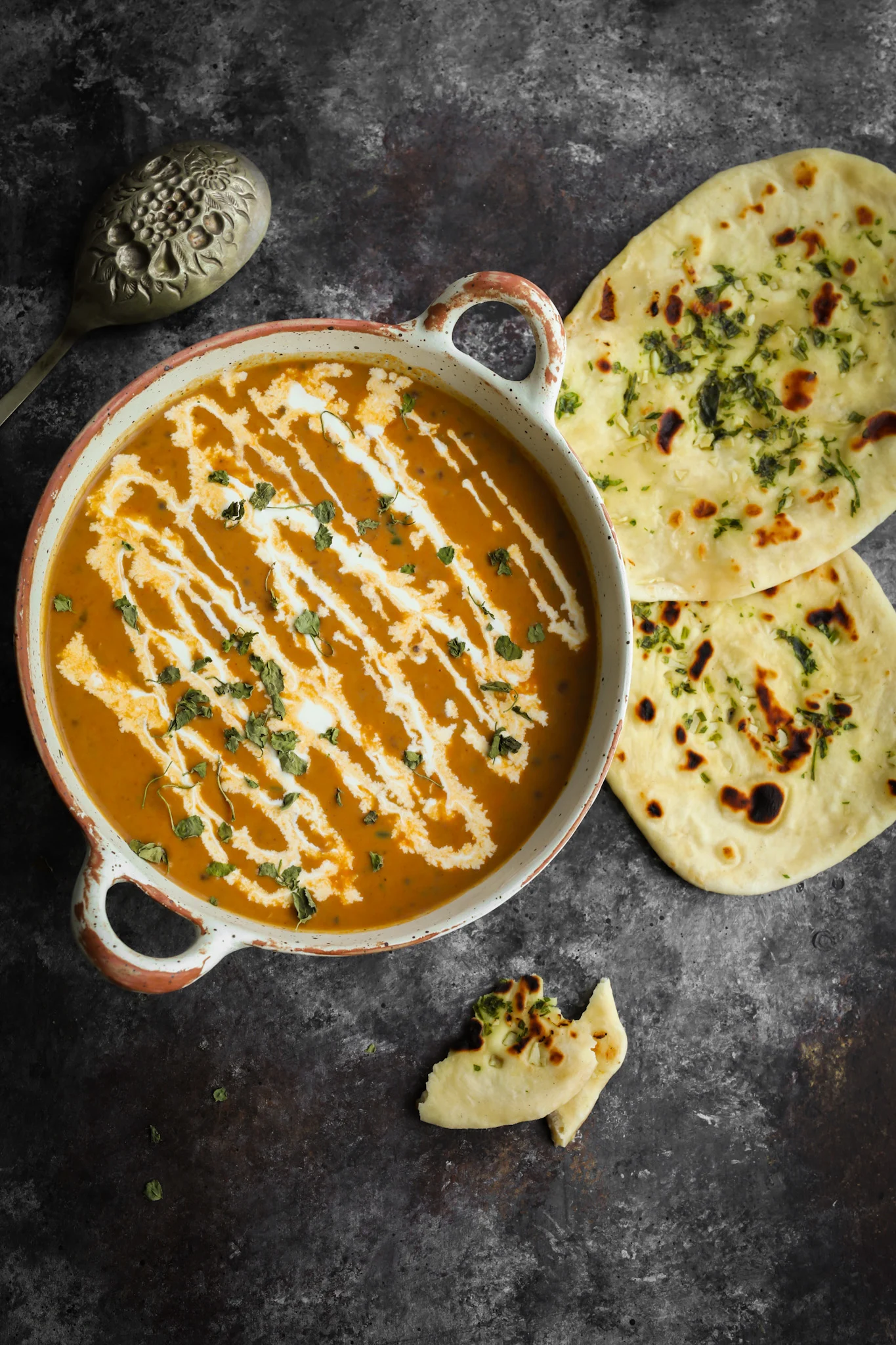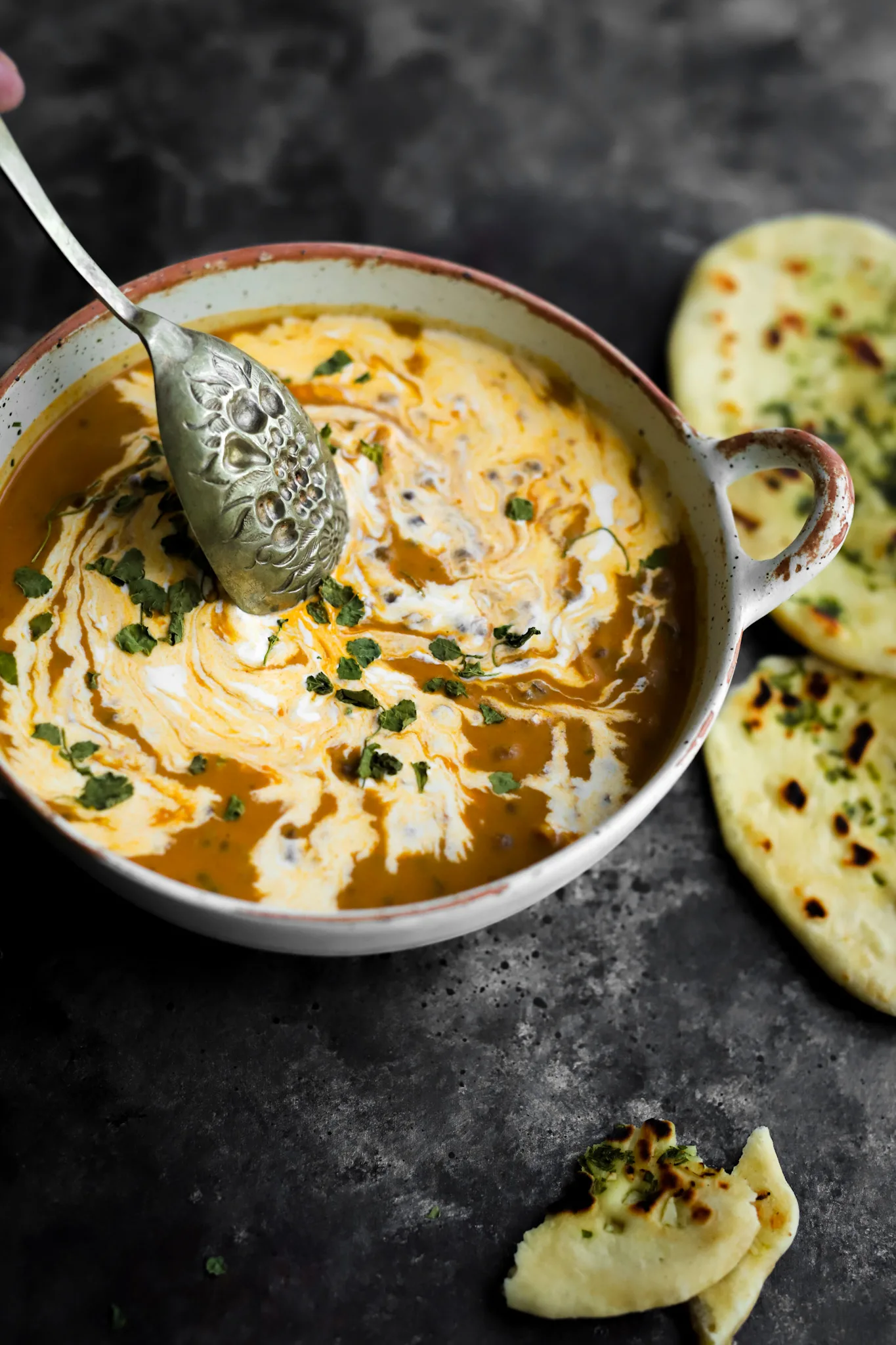Daal Makhani isn’t typical Indian home cooking. It’s slow and unmistakably rich. It’s unadulterated restaurant-style comfort food. However, this doesn’t mean you can’t make an excellent version of Vegan Daal Makhani at home. You absolutely can and should.
You can also replace the dairy with plant-based ingredients with very little impact on flavour and texture.
My favourite Vegan Daal Makhani recipe
Here’s my vegan Daal Makhani recipe for the days you crave a soulful dinner that calls for time and care.
I don’t carve out time in my schedule for such preparations but when I happen to have such foresight, this Daal Makhani is my go-to recipe.

Restaurant-style Daal Makhani in your home kitchen
Simmer it low and slow for a velvety, stick-to-your ribs texture. In restaurants, Daal Makhani is often cooked in a clay pot over coal overnight for deep smokiness and layers of flavour. My recipe follows suit and calls for slow cooking, but adapted for the home kitchen.
What type of lentils do I need?
Whole black urad (sabut urad or urid) are at the heart of any Daal Makhani recipe. Their onyx skin means they’re often referred to as black daal, despite being creamy white inside. Once soaked (and soak them you must), they take on a deep olive hue which mellows once boiled. Their texture is wholesome and starchy which lends this dish richness.
But what about the butter/cream?
To keep this Daal Makhani vegan, I use a combination of vegan butter and oat cream in place of dairy products. If you aren’t vegan, you can certainly use dairy butter and cream.

What equipment do I need?
Pressure cooker OR Instant pot/pressure pot
AND Slow cooker (a pressure pot with this function is also fine)
OR
Oven-safe casserole or Dutch oven with lid (optional if you would like to slow cook this for some time).
I use a combination of a conventional pressure cooker and the slow cooker function on my pressure pot. You can also cook this in a pressure pot from start to finish.

Equipment
- Pressure cooker or instant pot
Ingredients
- 220 g 220g urad (whole black gram)
- 50 g dried kidney beans
- 1/8 tsp baking soda
- 1.2 L water
- 1 tbsp oil or vegan butter
- 1 tsp cumin seeds
- 1 dried bay leaf
- 2 whole black cardamom
- 5 cm stick cinnamon
- 3 large cloves garlic crushed
- 2 tbsp ginger grated
- 2 tsp Kashmiri chilli powder or to taste
- 1/4 tsp turmeric
- 2 green cardamom pods, seeds ground
- 1 tsp ground coriander seeds
- 400 g fresh or tinned tomatoes blended
- 1 tbsp garam masala
- 1 tsp dried fenugreek leaves (kasoori methi)
- 2 tsp salt or to taste
- 100 ml oat cream
- 50 g vegan butter
- 1 tbsp chopped coriander leaves
To serve:
- 1 tbsp oat cream
- 1/4 tsp dried fenugreek leaves (kasoori methi)
- 2cm ginger julienned
Instructions
- In a bowl, mix together the urad and kidney beans. Wash well in plenty of water, changing the water at least 3 times until it's no longer murky. Add the baking soda and cover with lots of hot water. Cover and allow to soak for 6 at least 6 hours or overnight, if possible. Keep any water used by for feeding your indoor plants – they will love it!
- Drain the water from the soaked lentil and beans and wash again in plenty of water.
- Next, add the urad and kidney beans to a pressure cooker or pressure pot. Cover with 1.2L room temperature water and cook with the lid on until tender. For regular pressure cookers, this will be approximately 8 whistles, or 30 minutes if using a pressure pot (the stew/soup function does a good job of cooking them through). They should be cooked enough so that you can mash them with the back of a spoon.
- Heat 1 tbsp vegan butter or oil in a pan. Over a low heat, add the cumin seeds, black cardamom, bay leaves and cinnamon. Cook briefly and then add the ginger and garlic, garam masala, green cardamom, kasoori methi, turmeric, chilli powder, ground coriander seeds and salt.
- After a minute, add the tomatoes and mix well. Allow to cook for 5-10 minutes, over a medium-low heat until the oil separates from the sides of the pan. Partially cover the pan with a lid to stop it spluttering everywhere.
- Once the masala is cooked, add the cooked daal. Mix well. Take a sturdy spoon or ladle and begin to mash the daal against the base and sides of the pan to crush some of them. This is what thickens the daal for a perfect restaurant-style Daal Makhani. Do this over a low heat to stop it spluttering over your hands. Once it thickens a little, you're ready for the next step which is to simmer the daal low and slow.
For slow cooking:
- Quick: Continue to cook the daal in the same pan, covered for 35 minutes minimum. Stir often to avoid it sticking at the base of the pan.
- Medium/slow but so delicious: Transfer the daal to a slow cooker or pressure pot and slow cook (if using a pressure pot use the slow cook function) to cook the daal for a maximum of 12 hours). The longer you cook it, the better it will taste.
- Oven cook: Transfer the daal to a casserole dish or Dutch oven and cook at 100C/210F for a maximum of 12 hours. Stir every hour or so.
To serve:
- Stir 100ml oat cream and 50g vegan butter through the daal before serving.
- Garnish the daal with chopped coriander, ginger juliennes, kasoori methi and optional oat cream.
Recipe Video
Sanjana’s Notes
Pin it for later!

If you like this, you’ll love my recipe for Rajma

Love Sanjana


Restaurant-Style Peshwari Naan - Sanjana.Feasts - Bread + VIDEO
Friday 18th of August 2023
[…] Daal Makhani for Peshwari Naan […]
Shahi Daal - Sanjana.Feasts - Indian Recipes + VIDEO
Wednesday 29th of December 2021
[…] Daal Makhani […]